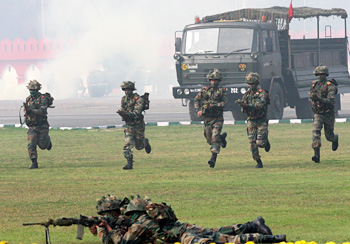INDIAN ARMED FORCES CHIEFS ON OUR RELENTLESS AND FOCUSED PUBLISHING EFFORTS

The insightful articles, inspiring narrations and analytical perspectives presented by the Editorial Team, establish an alluring connect with the reader. My compliments and best wishes to SP Guide Publications.

"Over the past 60 years, the growth of SP Guide Publications has mirrored the rising stature of Indian Navy. Its well-researched and informative magazines on Defence and Aerospace sector have served to shape an educated opinion of our military personnel, policy makers and the public alike. I wish SP's Publication team continued success, fair winds and following seas in all future endeavour!"

Since, its inception in 1964, SP Guide Publications has consistently demonstrated commitment to high-quality journalism in the aerospace and defence sectors, earning a well-deserved reputation as Asia's largest media house in this domain. I wish SP Guide Publications continued success in its pursuit of excellence.
New Indigenous Bullet Proof Jacket for Forces
 |
By Lt. General P.C. Katoch (Retd) Former Director General of Information Systems, Indian Army |

In an article titled 'Bullet Resistant Vests' in April this year, it was reported in these columns that Amrita University, Coimbatore is offering highly advanced technology bullet proof jackets (BPJs) and the proposal titled "Development of Hyper Velocity Impact Resistant Ultra Light Weight High Temperature Resistant Thermoplastic Polymer-Carbon Fiber Composite" was lying with MoD. The University had claimed that this bullet resistant vest had passed the most up to date National Institute of Justice Standard 0101.06, and offers protection from full contact shots, since many times professionals accidentally get shot by their own firearm from extremely close range. Amrita University had sent the proposal to DRDO and the joint propel TDF-DRDO was then sent to MoD.
Dr Shantanu Bhowmik, Head Research & Projects, Department of Aerospace Engineering, Amrita University, Coimbatore also wrote to then Defence Minister Manohar Parrikar that the proposal needs to be progressed expeditiously since similar research is ongoing by foreign companies like Boeing, EADS, Airbus, Lockheed Martin, Bombardier etc for developing high performance thermoplastic-carbon fibre composite for various applications in aviation and defence, and that Amrita University is in the forefront of this technology globally. He had, however, pointed out that delay in implementing this technology in India, would result in these foreign companies exploiting the Indian market. At that time, the fate of the proposal sent to the MoD was not known but it was hoped that case would be given priority since the claims by Amrita University had ample weight, with the joint proposal having been sent through the DRDO. Now the good news is that this bullet-proof jacket designed by Dr Shantanu Bhowmick has finally received the government's approval. The empowered committee of the MoD recently approved the jacket, which is made from indigenous ultra modern lightweight thermoplastic technology. It will be included in the Prime Minister's 'Make in India' project. The task of manufacturing the jackets will begin after the PMO gives it the green-light. This is the first time in 70 years that the Indian Army will have a bullet-proof jacket manufactured completely through indigenous technology. Presently, India spends some 1.5 lakh per jacket used by the Military and para-military forces (PMF).
Dr Bhowmick's jacket will cost about 50,000 per jacket. Besides, the present bullet proof jackets being used security forces weigh anywhere between 10-15 kgs. These new light weight jackets weigh 6-8 times less at just 1.5 kg. It has 20 layers and the carbon fiber in it will enable the jacket to work in 57 degrees Celsius also. Dr Bhowmick has dedicated his invention to Netaji Subhas Chandra Bose. India has been fighting cross-border proxy wars, terrorism and insurgencies past three decades plus. The requirement of BPJs for every security forces fighter operating in counter insurgency and counter terrorist environment is the basic necessity. The fact that requisite BPJs in terms of numbers and quality have not been provided to our security forces is ironic, reflects inadequate focus at the cutting edge - the foot soldiers who are fighting every day. The Indian Army continues to remain deficient of modular BPJs despite the DAC having cleared the acquisition of 1,86,138 such BPJs in October 2009.
In 2014, then Defence Minister Parrikar had announced "emergent" procurement of quantity 50,000 modular BPJs for the Army, but these started trickling in last year in 2016 from Tata Advanced Materials Limited (TAML) and the last lot were delivered in March this year. The bigger case for acquisition of1.86 lakh jackets that were to be procured by year 2012, is still lingering but meanwhile the BPJs deficiency of the Army has gone beyond 3,50,000. With Dr Bhowmick's BPJ having been approved, here is a project that must be taken up under 'Make in India' with utmost speed, dispensing all red tape. The fact that no foreign collaboration and technology (ToT) is involved should facilitate early production. Considering the mammoth numbers required by the Military, PMF and Police forces, multiple production lines would need to be established. The venture without doubt has tremendous potential for exports, provided we can productionize and market these bullet resistant vests before the foreign firms catch up. At the same time, our focus should weigh more towards meeting internal requirements vis-à-vis exports.





